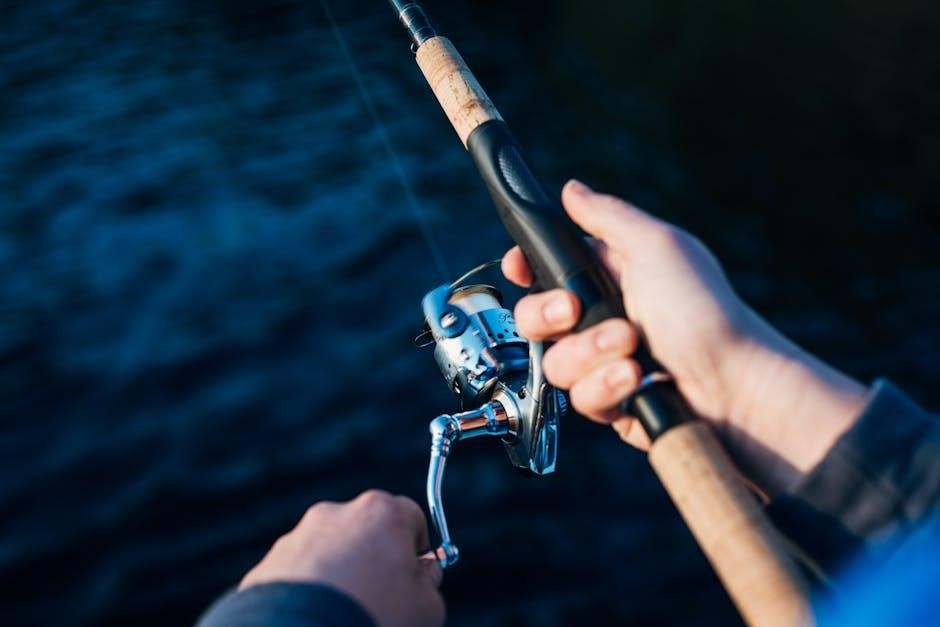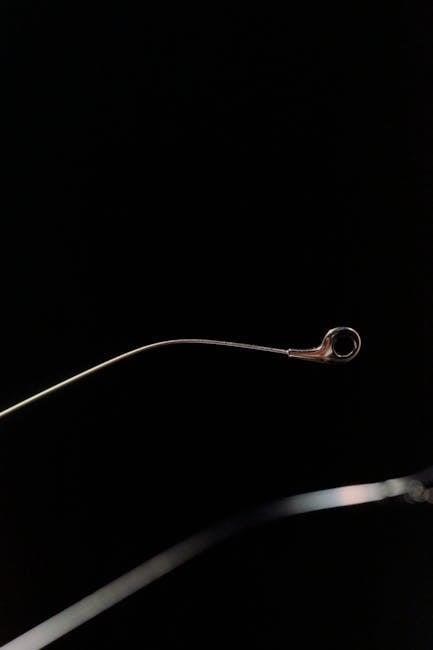Rod guides are vital components of fishing rods, acting as pathways for the fishing line. They significantly impact casting distance, accuracy, and overall fishing experience. Modern upgrades have improved sensitivity and heat dissipation.

Types of Rod Guides
Fishing rod guides come in several types, each designed for specific applications and rod types. Common types include spinning rod guides, casting rod guides, and fly rod guides, each with unique characteristics.
Spinning Rod Guides
Spinning rod guides are designed to efficiently manage the line coming off a spinning reel. Typically, they feature a larger first guide, known as the stripping guide, placed closer to the reel. This guide helps to gather the line as it spirals off the spinning reel’s spool, minimizing friction and preventing line slap on the rod blank.
Subsequent guides gradually decrease in size towards the rod tip, maintaining line control and maximizing casting distance. These guides are usually lightweight to preserve the rod’s sensitivity and action. The spacing and placement of spinning rod guides are crucial for optimal performance, ensuring smooth and accurate casts. High-quality materials, like ceramic inserts, are often used to reduce friction and heat buildup, especially when using braided lines. The number of guides also plays a role, with more guides generally providing better line control and distribution of stress along the rod blank.
Casting Rod Guides
Casting rod guides are specifically engineered to complement baitcasting reels. They differ significantly from spinning rod guides in their size and placement. Casting rods typically feature smaller, more numerous guides that are positioned closer to the rod blank. This design helps to control the line as it comes off the rotating spool of a baitcasting reel, minimizing backlash and maximizing casting accuracy.
The guides on a casting rod are typically arranged in a spiral or low-profile configuration. This arrangement is crucial for managing the line’s trajectory and preventing it from rubbing against the rod blank during the cast. High-quality materials, such as silicon carbide (SiC) or titanium oxide, are often used in casting rod guides to reduce friction and heat buildup, especially when using braided lines. The frame material is equally important, with stainless steel being a common choice for its durability and corrosion resistance. The size and spacing of casting rod guides are carefully calibrated to optimize casting performance and sensitivity.
Fly Rod Guides
Fly rod guides are uniquely designed to handle the specific demands of fly fishing. Unlike spinning or casting rods, fly rods use heavier lines that are cast using a different technique. Fly rod guides are typically lightweight and minimalist to avoid dampening the rod’s action and to allow the line to shoot smoothly.
Snake guides are the most common type of guide found on fly rods. These guides are made from a single piece of wire that is bent into a series of loops. The loops are small and close together, which helps to control the fly line and prevent it from tangling. Stripping guides, which are larger and located closer to the reel, are also used on fly rods to manage the line as it is retrieved. The materials used in fly rod guides are chosen for their lightweight and durability, with stainless steel and titanium being popular choices. The placement and spacing of fly rod guides are crucial for optimizing the rod’s performance and ensuring smooth, accurate casts.

Materials Used in Rod Guide Construction
Rod guide materials greatly influence performance, sensitivity, and durability. Modern guides utilize advanced ceramics like silicon carbide (SiC) and titanium carbide. Frames are often stainless steel or titanium, balancing strength and weight for optimal functionality;
Silicon Carbide (SiC)
Silicon carbide, commonly referred to as SiC, is often considered one of the best materials available today for fishing rod guides. It is a popular choice because it offers a super smooth surface, which minimizes friction on the line during casting, ultimately leading to longer casts and improved performance.
SiC guides are known for their exceptional heat dissipation properties. The advanced ceramic ring guides reduce friction and heat to a bare minimum; This is particularly important when using braided lines, which can generate significant heat due to their abrasive nature. By effectively dissipating heat, SiC guides help to prevent line damage and breakage.
SiC is a popular material choice in rod guides because of its lightweight design and durability. The price of a single guide on a spinning rod can vary greatly, but SiC is typically chosen for premium rods.
Titanium Carbide
Titanium carbide stands out as a premium material frequently employed in the construction of high-quality fishing rod guides. Sharing the spotlight with silicon carbide (SiC), titanium carbide is celebrated for its exceptional blend of lightweight design and remarkable durability, making it a sought-after choice among anglers.
One of the key advantages of titanium carbide lies in its ability to withstand the rigors of demanding fishing conditions. Its robust composition ensures that the guides maintain their structural integrity, even when subjected to the stresses of casting heavy lures or battling powerful fish. This durability translates into a longer lifespan for the rod guides.
Like SiC, titanium carbide guides are often found on higher-end rods, reflecting their premium nature and enhanced performance characteristics. Their ability to withstand thin braided lines is another beneficial trait.
Ceramic Inserts
Ceramic inserts play a pivotal role in the performance of rod guides, serving as the contact point for the fishing line as it travels along the rod. These inserts are meticulously crafted from various ceramic materials, each offering a unique blend of properties tailored to enhance the angler’s experience.
The primary function of ceramic inserts is to minimize friction between the line and the guide. By providing a smooth, polished surface, they allow the line to glide effortlessly during casting and retrieval, resulting in increased casting distance and reduced wear on the line.
Guide manufacturers have developed a number of ceramic insert options and each offer something a little different. These rings can vary greatly in price, from very affordable to very expensive. Cobalt/aluminum based guide rings are also very common.
Stainless Steel Frames
Stainless steel frames form the structural backbone of many rod guides, providing the necessary strength and durability to withstand the rigors of fishing. These frames are typically constructed from high-quality stainless steel alloys, chosen for their resistance to corrosion, even in harsh saltwater environments.
The primary function of the stainless steel frame is to securely hold the ceramic insert in place and to attach the guide to the fishing rod blank. The frame must be robust enough to withstand the forces exerted on the guide during casting, retrieving, and fighting fish, preventing the insert from dislodging or the guide from bending or breaking.
The frame of the guide, which supports the insert, is typically constructed from stainless steel. Frame Material: Titanium Frame Colour: Silver. They have evolved primarily from thin metal sheets to plastics.

Factors to Consider When Choosing Rod Guides
Selecting the right rod guides involves considering rod type, fishing style, and line type. Guide size and placement are crucial for optimal performance and casting distance. A proper understanding enhances fishing experience.
Rod Type and Fishing Style
Choosing rod guides heavily depends on the specific rod type and preferred fishing style. For spinning rods, consider guides that minimize friction for longer casts. Casting rods often require guides designed to handle heavier lines and baitcasting reels. Fly rods need specialized snake guides for smooth line flow during casting.
Match the guide material to the rod’s action; faster action rods benefit from lighter guides. The size and placement of guides should complement the rod’s intended use, whether it’s for delicate presentations or heavy-duty saltwater fishing. Consider the target species and the techniques you’ll be using.
Ultimately, selecting rod guides that align with your rod and fishing style will enhance your overall angling experience, improving casting performance, sensitivity, and control.
Line Type Compatibility
Line type compatibility is crucial when choosing rod guides. Braided lines, known for their strength and sensitivity, require guides with durable inserts like silicon carbide (SiC) or titanium oxide to prevent grooving. Monofilament lines are generally compatible with a wider range of guide materials, but ceramic inserts offer smoother casting.
Fluorocarbon lines, nearly invisible underwater, also benefit from smooth guide surfaces to minimize friction. Consider the line’s diameter and abrasion resistance when selecting guide size and material. Using incompatible guides can lead to premature line wear, reduced casting distance, and potential line breakage during critical moments.
Ensure the guides’ inner diameter is adequate for the line’s knot size to prevent snagging. Matching guide material to line type ensures optimal performance and prolongs the lifespan of both the line and guides.
Guide Size and Placement
Guide size and placement are critical for optimal rod performance. Larger stripping guides, located nearest the reel, manage the line as it comes off the spool, reducing friction and improving casting distance. Progressively smaller guides towards the rod tip control line flow and prevent tangling.
Proper placement ensures even distribution of stress along the rod blank during casting and fighting fish. The number of guides also affects performance; more guides generally provide better line control and sensitivity. Experienced rod builders use guide spacing charts or dynamic testing to determine the ideal placement for a specific rod blank and fishing style.
Incorrect placement can lead to energy loss, decreased casting distance, and increased risk of line breakage. Consider the rod’s action and intended use when determining guide size and placement for a balanced and efficient setup.

Rod Guide Brands and Manufacturers
The fishing rod guide market boasts a diverse range of brands and manufacturers, each offering unique technologies and designs. Fuji stands out as a leading name, renowned for its high-quality guides and innovative materials like SiC and Torzite. Pacific Bay is another prominent manufacturer, offering a wide selection of guides for various fishing applications.
American Tackle is also well-regarded, known for its cutting-edge designs and focus on performance. Other notable brands include Aftco, known for its durable roller guides for saltwater fishing, and Batson/Rainshadow/ALPS, which provides a range of rod building components, including guides.
Winthrop Tackle specializes in heavy-duty guides for big game fishing. Anglers can also find guides from CRB, and smaller custom rod building suppliers. Ultimately, the best brand depends on individual needs and preferences.